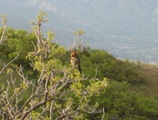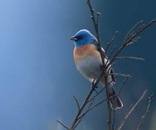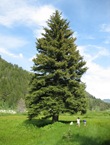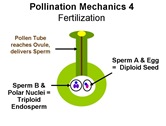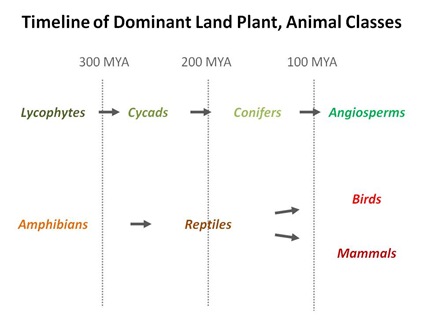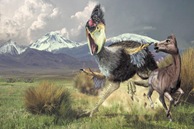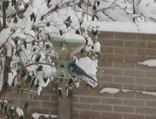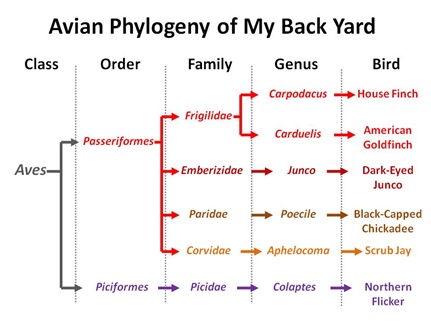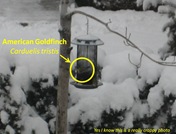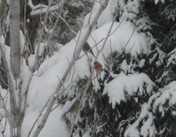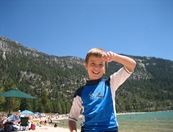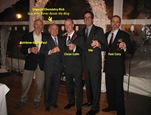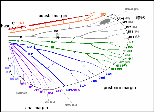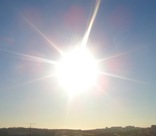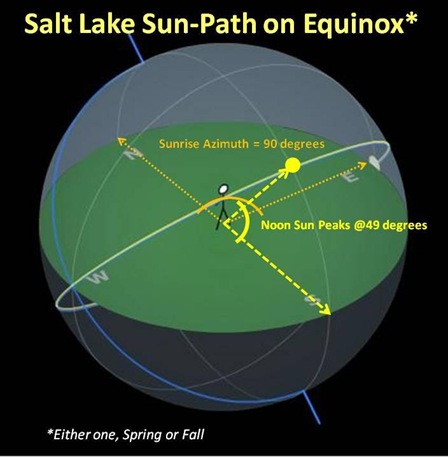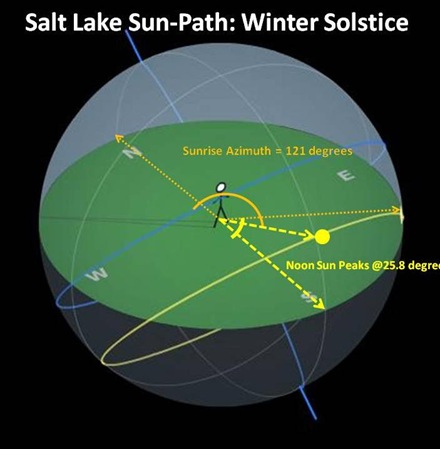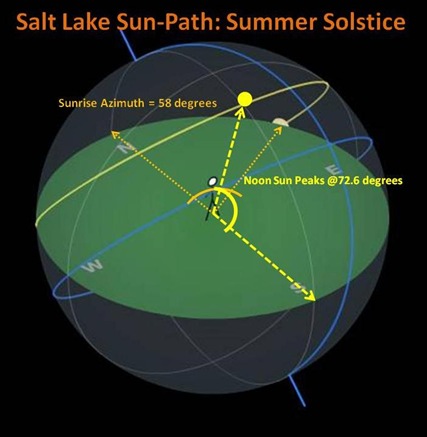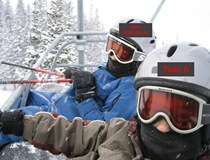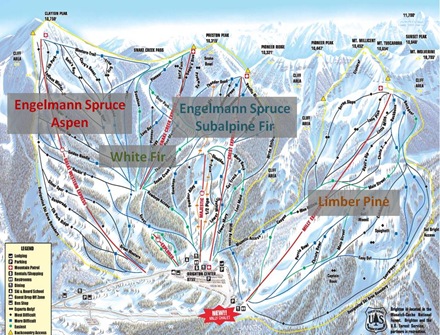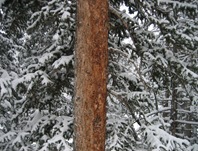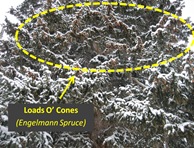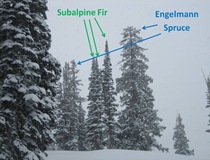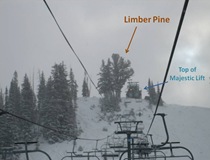This past weekend was my first real backcountry ski day of the season, by which I mean not just going to a resort or skinning up Porter Fork or Mill Creek, but a real backcountry ski day, where you pack beacon & shovel, skin up a couple thousand feet and yo-yo ski several runs, while trying not to get killed in an avalanche.
Ski Tangent: I do 3 types of skiing: resort (mainly with family), XC (mainly in the Uintas) and backcountry. My backcountry setup includes nice wide skis (Volkl Snowrangers) and heavy plastic boots (Garmont Liberos). I use skins with these skis to ascend slopes, and I spend most of my time on telemark skis between 7,500 and 9,500 feet, ascending into a suitable area- usually somewhere up Big Cottonwood Canyon- where I can yo-yo ski several runs. 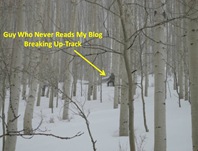 The initial descent usually entails the grueling job of breaking a “skin-track” up; successive ascents on the same track take only maybe ½ the effort. I usually do this with friends, but sometimes solo as well. Despite being on telemark skis, nearly all of my turns are alpine turns, but I like the low-weight and flexible boots of telemark gear, both for climbing as well as picking/stepping my way out of brushy or problematic areas.
The initial descent usually entails the grueling job of breaking a “skin-track” up; successive ascents on the same track take only maybe ½ the effort. I usually do this with friends, but sometimes solo as well. Despite being on telemark skis, nearly all of my turns are alpine turns, but I like the low-weight and flexible boots of telemark gear, both for climbing as well as picking/stepping my way out of brushy or problematic areas.
This type of skiing is by far the most dangerous of the 3. It requires safety gear (beacon, shovel, probe), knowledge of snow conditions, caution and good sense. Different backcountry skiers take different approaches to avalanche safety. Some are virtual “snow scientists”; run into them on the skin-track and they’ll talk you into a daze with details of crystal formation and snow compaction. 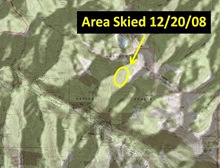 Other skiers focus more on safety gear (i.e. Avalung) while still others focus primarily on slope, terrain and anchor points. I use a 4th strategy that encompasses elements of all of these and other techniques and which I refer to as Being A Total Pussy. That’s right, I am a total pussy in the backcountry. None of us knows how we’ll go, but I am determined not to spend my final minutes suffocating under snow. I stick to shallow-angle slopes, in the trees, under all but the most benign conditions.
Other skiers focus more on safety gear (i.e. Avalung) while still others focus primarily on slope, terrain and anchor points. I use a 4th strategy that encompasses elements of all of these and other techniques and which I refer to as Being A Total Pussy. That’s right, I am a total pussy in the backcountry. None of us knows how we’ll go, but I am determined not to spend my final minutes suffocating under snow. I stick to shallow-angle slopes, in the trees, under all but the most benign conditions.
Organic-Chemistry-Rick (guy who never reads my blog), our friend Jane, and I skinned up into the Beartrap drainage on the North side of big Cottonwood Canyon (map above, right), and despite the abysmal weather (super-cold, high winds) and fairly meager early-season snow cover, found some great snow and had a good day.
 Science Fiction Tangent: I have a weak spot for end-of-the-world, Armageddon-type movies. The weekend before last, when Awesome Wife was away, I watched “I Am Legend”, which is set in the ruins of a post-plague New York City. The movie’s real eerie, because the protagonist is driving and exploring all around this abandoned, overgrown city, which of of course used to be all busy and bustling with activity.
Science Fiction Tangent: I have a weak spot for end-of-the-world, Armageddon-type movies. The weekend before last, when Awesome Wife was away, I watched “I Am Legend”, which is set in the ruins of a post-plague New York City. The movie’s real eerie, because the protagonist is driving and exploring all around this abandoned, overgrown city, which of of course used to be all busy and bustling with activity.
That’s the same feeling I get the first backcountry ski day of the season. It’s always the first return to the high backcountry that I last saw in Summer or Fall, and often the exact same hillsides I hiked or biked just months ago (for example on this tour we were skiing within 100 yards or so of the Wasatch Crest trail.) 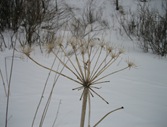 But where there were leaves and flowers and birds and crickets and all kinds of great smells the last time I was here, now there’s just silence, wind and bare trees. In the early winter, this “ruins” feel is exacerbated by the dead shrubs sticking out of the snowpack. Recognize this guy? (pic left) It’s the remains of a Cow Parsnip stalk, Heracleum maximum, it’s double composite flower-head architecture still clear in death.
But where there were leaves and flowers and birds and crickets and all kinds of great smells the last time I was here, now there’s just silence, wind and bare trees. In the early winter, this “ruins” feel is exacerbated by the dead shrubs sticking out of the snowpack. Recognize this guy? (pic left) It’s the remains of a Cow Parsnip stalk, Heracleum maximum, it’s double composite flower-head architecture still clear in death.
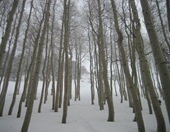 We skied several runs through an Aspen forest. I’ve gone on previously about the beauty of Aspen forests in both Summer and Fall, but in the Winter they have yet another kind of beauty- ghostly, quiet and open, and this winter beauty has a weird, almost otherworldly quality to it. If you’ve ever read C.S. Lewis’ “The Magician’s Nephew”, Aspen forests in winter somehow remind me of the “Wood Between The Worlds”, which isn’t really part of any world, but leads to all worlds.
We skied several runs through an Aspen forest. I’ve gone on previously about the beauty of Aspen forests in both Summer and Fall, but in the Winter they have yet another kind of beauty- ghostly, quiet and open, and this winter beauty has a weird, almost otherworldly quality to it. If you’ve ever read C.S. Lewis’ “The Magician’s Nephew”, Aspen forests in winter somehow remind me of the “Wood Between The Worlds”, which isn’t really part of any world, but leads to all worlds.
 On a more mundane level, Aspen forests offer the best tree-skiing in the Wasatch. They’re open, nicely-spaced, with no winter-foliage to prevent snowfall from reaching the forest floor. Remember the tree-rule of backcountry skiing: break the up-track through PLTs, but ski down through Aspens.
On a more mundane level, Aspen forests offer the best tree-skiing in the Wasatch. They’re open, nicely-spaced, with no winter-foliage to prevent snowfall from reaching the forest floor. Remember the tree-rule of backcountry skiing: break the up-track through PLTs, but ski down through Aspens.
Aspens in the Wasatch almost always reproduce clonally, and so there’s a good chance we spent the bulk of the day skiing inside a single clone. As we repeatedly re-ascended our skin-track, I had plenty of time to think about what these trees are doing in Winter.
Back in the summer when I first blogged about Aspen, I went on and on about their genetics, evolution and foliage, but I glossed over 2 of the most remarkable things about this tree. The first is that it is so ALONE. Think about it: as you hike, ski, bike, or just drive through the Wasatch, away from the creeks, there’s only 1 deciduous real tree in the mountains- Aspen. Everything else is a PLT or maybe a Mountain Mahogany or a Rocky Mountain Juniper. And what’s more, is Aspen stands alone clear across Northern/Northwestern North America. Go up to Montana, or Idaho, or down to New Mexico, or clear up to the Yukon, stay away from the streamside stuff, and know what the only deciduous tree you’ll find is? That’s right, Aspen. And there’s more! Zip across the Bering Strait and start cruising across the boreal forests of Siberia, and there’s pretty much just one deciduous, non-riparian, tree alongside the Pines and PLTs of the Russian North- Eurasian Aspen, Populus tremula.
 And this alone-ness segues directly into the 2nd remarkable thing about Aspen: its competitiveness. Aspens in the Wasatch and elsewhere are surrounded by conifers (PLTs here, PLTs + Pines elsewhere.) Every Spring, while the Aspens waste valuable weeks growing new leaves, the conifers, with their needles ready, start photosynthesizing and growing. As soon as the temps bust 50F, they’re kicking it. How do Aspens compete?
And this alone-ness segues directly into the 2nd remarkable thing about Aspen: its competitiveness. Aspens in the Wasatch and elsewhere are surrounded by conifers (PLTs here, PLTs + Pines elsewhere.) Every Spring, while the Aspens waste valuable weeks growing new leaves, the conifers, with their needles ready, start photosynthesizing and growing. As soon as the temps bust 50F, they’re kicking it. How do Aspens compete?
One way of course, we’ve already talked about: they spread clonally and quickly, taking advantage of disturbances such as avalanches, forest fires and clear-cuts. But it turns out that Aspen has another trick to compete with the PLTs: photosynthetic bark.
When we think of chlorophyll, we think of leaves. (See this post for some basic info on chlorophyll, and an overview of the symbiotic evolution of chloroplasts.) But more than 60 species of tree and woody shrub have been found to contain substantial amounts of chlorophyll in their bark. Of all of them, Aspen is the champion, with more chlorophyll in its bark than any other tree known. The bark-chlorophyll in Aspen is concentrated in a super-thin layer (about the thickness of a leaf) that lies within 1mm of the exterior surface of the bark. (The exterior layer is called the periderm. When you brush your hand against an Aspen trunk, that white powder that comes off is dead periderm cells.)
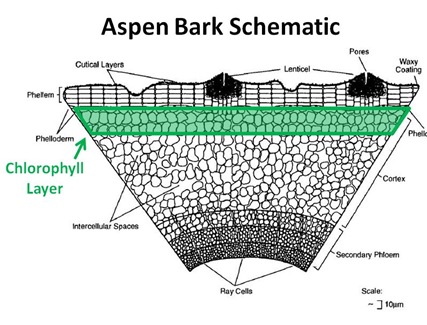 The photosynthetic layer comprises less than 5% of the total volume of bark on the tree, but it accounts for a whopping 17-40% of all the tree’s chlorophyll when the tree is fully leaved. The bark-chlorophyll is most heavily concentrated on the upper, South-facing trunks.
The photosynthetic layer comprises less than 5% of the total volume of bark on the tree, but it accounts for a whopping 17-40% of all the tree’s chlorophyll when the tree is fully leaved. The bark-chlorophyll is most heavily concentrated on the upper, South-facing trunks.
Tangent: At this point an astute reader may be thinking, “Ah-ha! That’s why I sometimes see Aspen trunks that have a greenish tinge. That must be bark-chlorophyll.” To which the answer is “Yes, but…” The greenish tinge of the bark of some Aspens does indeed indicate the presence of chlorophyll. But a greenish tinge doesn’t necessarily mean that a given tree has more chlorophyll than an Aspen with pure white bark. The whiter Aspen may just have more dead periderm cells on/in its bark.
The presence of chlorophyll in its bark appears to help Aspen in a couple of ways. First it provides a photosynthetic head-start in Springtime, before its new leaves have developed. This appears to be especially important in younger Aspen, and it negates at least some of the early-season photosynthetic advantage enjoyed by neighboring PLTs. Even during the summer, bark chlorophyll accounts for 10%-15% of all photosynthetic activity in a typical Aspen.
But the second way bark chlorophyll helps Aspen is in utilizing or “refixing” CO2 given off by the tree. Even in winter, trees continue to respire, and as they do so, lose CO2. Bark-chlorophyll is able to recapture some of this CO2 through photosynthesis, which in turn helps create a more aerobic environment inside the tree which helps defend against certain fungal infections.
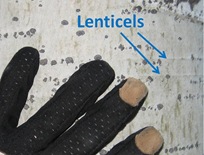 Lastly, bark-chlorophyll may help Aspen- even in summer- in times of drought-induced stress. The stomata (pores) in leaves respond to drought by closing, which in turn stops any photosynthesis. But bark is able to continue exchanging gases- and thereby continue photosynthesis- through structures called lenticels, which show up as the horizontal lines on Aspen bark (though lenticels are in no way unique to Aspen.)
Lastly, bark-chlorophyll may help Aspen- even in summer- in times of drought-induced stress. The stomata (pores) in leaves respond to drought by closing, which in turn stops any photosynthesis. But bark is able to continue exchanging gases- and thereby continue photosynthesis- through structures called lenticels, which show up as the horizontal lines on Aspen bark (though lenticels are in no way unique to Aspen.)
Tangent: Of course the type of photosynthesis we’re talking about in Aspen is the “standard”, C3 photosynthesis. But we’ve already seen that there’s at least one other photosynthetic process, C4 photosynthesis, which we talked about way back during Weed Week (man, was that a cool week or what?) when we looked at Crabgrass. And it turns out that there’s another (yes a third!) type of photosynthesis that actually functions while the stomata are closed. I’m hoping to visit a number of plants that employ this third type of photosynthesis sometime in the next 60-90 days, but in the meantime I’ll give you a quick hint: This week, UTRider is surrounded by plants that use this third type of photosynthesis.
I’ve been skiing, biking and hiking in Aspens for nearly 2 decades, and they never cease to fascinate me. When I first encountered them, it was their visual and sonic beauty that caught my attention. As I’ve gotten to know them better I’ve become awed by their elegance, engineering and sophistication. Aspens are way cool.
 Berry-Go-Round #12 is up over at my favorite blog, Foothill Fancies. This month’s Berry-Go-Round features a number of great plant-related posts on everything from evolution in Mexican dry forests to cycads in the Caribbean. Go check it out!
Berry-Go-Round #12 is up over at my favorite blog, Foothill Fancies. This month’s Berry-Go-Round features a number of great plant-related posts on everything from evolution in Mexican dry forests to cycads in the Caribbean. Go check it out! And speaking of Berry-Go-Round, guess where the next edition- BGR #13- is being hosted? That’s right kids, right here on Watching the World Wake Up, right around January 28! I somehow managed to convince the moderator that this is actually a respectable tree-blog, and a suitable location for this excellent blog carnival (I must be a great salesguy!)
And speaking of Berry-Go-Round, guess where the next edition- BGR #13- is being hosted? That’s right kids, right here on Watching the World Wake Up, right around January 28! I somehow managed to convince the moderator that this is actually a respectable tree-blog, and a suitable location for this excellent blog carnival (I must be a great salesguy!)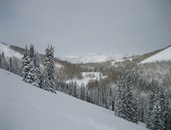 All plant-related submissions are welcome, but some ideas that might be of interest to readers in Winter climes (like here in Utah, where we are currently freezing our butts off) might include plant survival in Winter, desert plants, or any posts about plants in the tropics or (even better) the Southern Hemisphere.
All plant-related submissions are welcome, but some ideas that might be of interest to readers in Winter climes (like here in Utah, where we are currently freezing our butts off) might include plant survival in Winter, desert plants, or any posts about plants in the tropics or (even better) the Southern Hemisphere. A: Hello? Have you been reading this blog? Don’t you get by now how totally, completely, way cool plants are?? Seriously, if you’re not dialed into plants, or at least trees, you should be. All around you are these wonderful, green, growing, changing creatures that make the world so much more interesting and beautiful, each with its own hidden story to tell. As I’ve said before, the world is ruled by plants; we’re just along for the ride.
A: Hello? Have you been reading this blog? Don’t you get by now how totally, completely, way cool plants are?? Seriously, if you’re not dialed into plants, or at least trees, you should be. All around you are these wonderful, green, growing, changing creatures that make the world so much more interesting and beautiful, each with its own hidden story to tell. As I’ve said before, the world is ruled by plants; we’re just along for the ride. A: It means this: January is Grown-Up Month at Watching the World Wake Up. All month long, I’m going to do my darndest to run this blog like a grown-up blog, with more cool science stuff, and less irresponsible goings-on about reclining airline seats, Sunday School, old neighbors and hotel sex.
A: It means this: January is Grown-Up Month at Watching the World Wake Up. All month long, I’m going to do my darndest to run this blog like a grown-up blog, with more cool science stuff, and less irresponsible goings-on about reclining airline seats, Sunday School, old neighbors and hotel sex.
